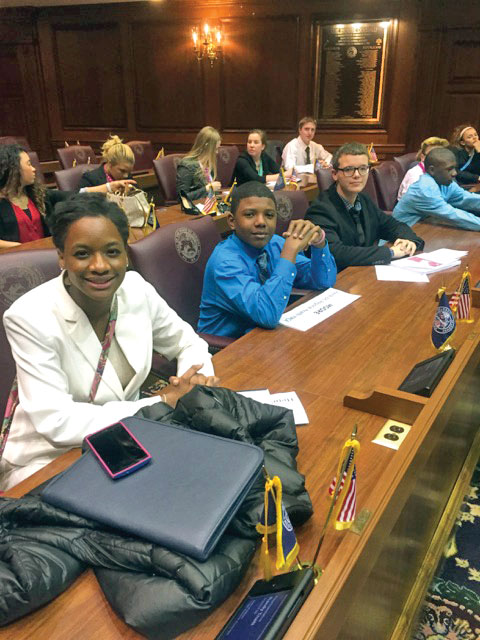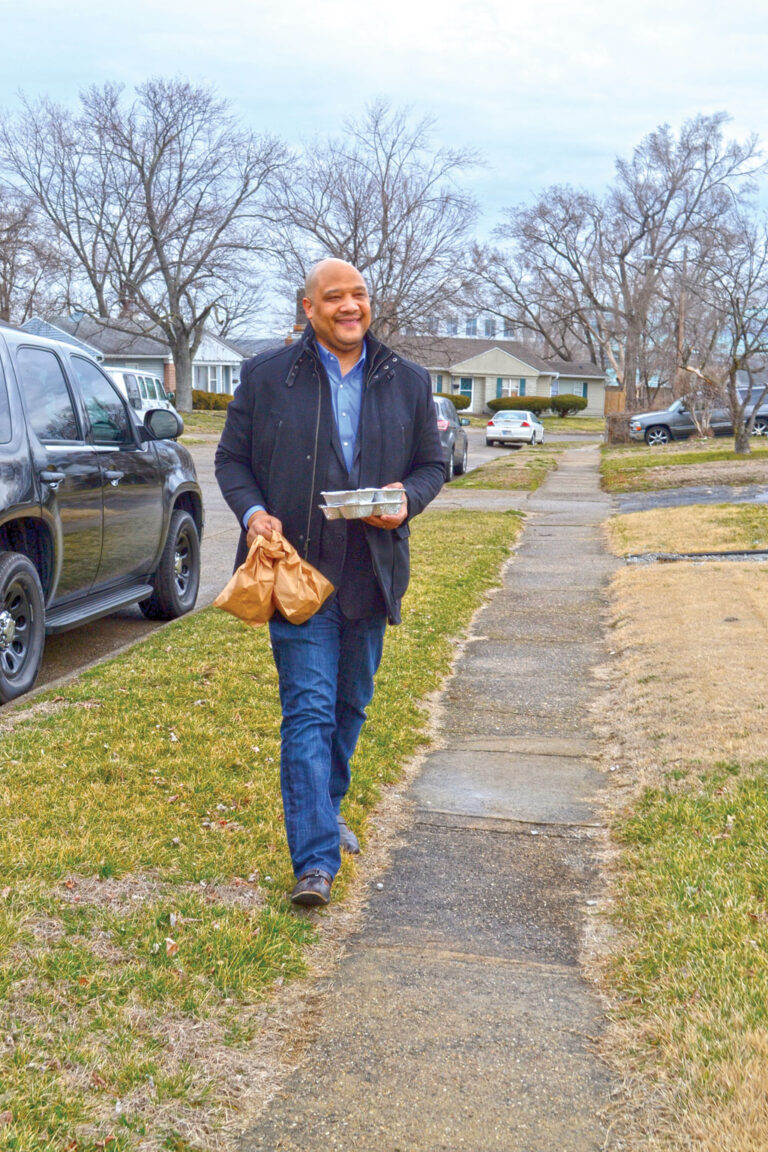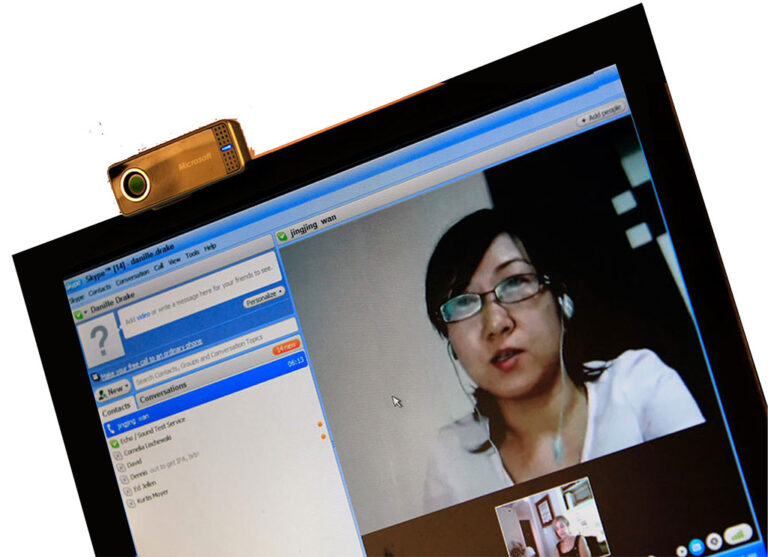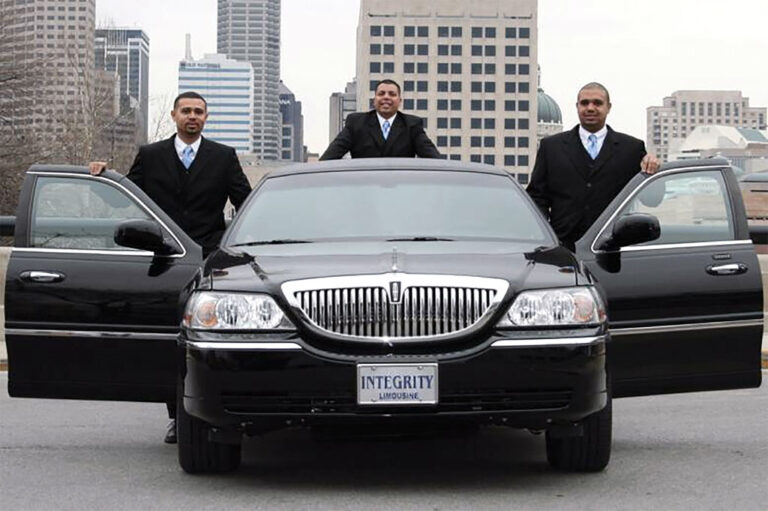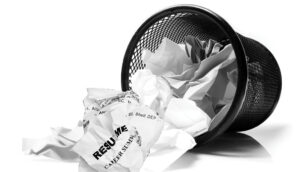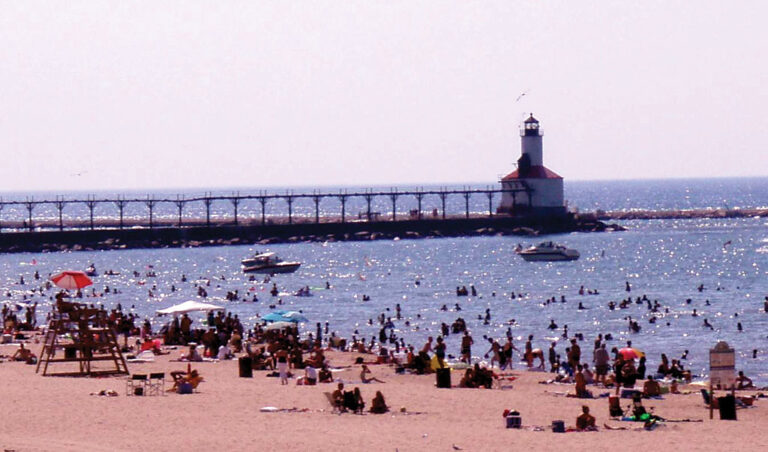United Capital of Indianapolis, a financial life management firm, gifts $10,000 to Wheeler Mission Ministries, a nonprofit organization that provides critically needed goods and services to the homeless and underprivileged.
Teens take over the Statehouse
Alexis Taylor, a junior at Avon High School in Avon, Indiana; Alfred Moore, eighth-grader at Lynhurst 7th & 8th Grade Center in Indianapolis; and Connor Grant, eighth-grader at Franklin Township Middle School East in Indianapolis, sit in the chamber of the Indiana House of Representatives as they await the State of the State address at the annual Indiana YMCA Youth and Government Model Government Conference.
Carson celebrates 45th anniversary of Meals on Wheels
To help celebrate the 45th anniversary of Meals on Wheels, U.S. Rep. Andre Carson, D-Ind., picks up meals from Eskenazi Health to deliver to central Indiana residents. Each meal is prescribed by a physician in accordance with the client’s medical history. In 2015, the organization served 3,200 individual clients.
Letting LinkedIn work for you
By Ann Carmichael
Today, everything is online. Whether you are looking for a job or you are a searching for qualified job seekers, using the Internet is a viable tool. One of the most important networking tools for employers and employees is LinkedIn. LinkedIn was created in 2002 and launched in 2003 and has grown rapidly. Currently, the network has more than 350 million members in approximately 200 countries around the globe.
From the beginning, the goal of LinkedIn was to connect people in order for them to lead a more productive and successful lifestyle. Well-known for employment, it is also an effective tool for organizations and entrepreneurs. If you want to get your name “out there,” LinkedIn is the perfect way to go.
Most of those who use LinkedIn are either looking for work or looking for workers. Juan Phillips, a career advisor at Chicago State University (CSU), says using online resources such as LinkedIn for job searches is mandatory.
When advising students, the first thing Phillips tells them is it’s imperative to have an online presence. “Anything having to do with employment is online today, regardless if you filling out a job application or you are looking for available positions in a specific profession,” he says. “Resources, like LinkedIn, are strong tools in helping in a career search.”
But he also warns his students to keep their LinkedIn profile professional at all times. He states that, unlike Facebook, the majority of the individuals who use LinkedIn are business professionals, including those in various HR positions. Phillips says when it comes to LinkedIn, “You have to present the best profile you can.”
How to use
LinkedIn has become so popular that many career advising centers offer LinkedIn workshops. CSU offers one in which they help students, alumni and residents in the community set up a LinkedIn profile, including putting together a resume and online portfolio for those in the graphic designing, marketing and writing/editing.
For a LinkedIn profile, it should not only list your education and work experience, but it should also have a link to an online portfolio, especially if you are in the editing/writing, art, marketing or graphic design professions. Furthermore, if you have a professional blog, you can connect it to your LinkedIn profile. If a head hunter is on LinkedIn looking for prospective employees, he or she wants to see who you are and what you have done.
Say it with words
If you are wondering what HR departments are looking for when they view your LinkedIn profile, it is more than just your college degree. T. McCline, an HR associate at CSU for 17 years, says when she sees an online profile, she wants the words to jump off the page. “I need to hear creativity, desire and a hunger for advancement in what you write about yourself.” McCline said because she has been in HR for so long, she can tell from personal statements and cover letters if a prospective employee is a self-starter and team player. “Like most companies, HR looks for people who don’t have to be micro-managed all day, every day.”
As far as LinkedIn is concerned, McCline does agree that it is a helpful tool in looking for potential employees. However, she warns there are some negatives. For example, LinkedIn strongly recommends those who sign up for membership include a photo. McCline says for people of color, this could be an issue. “There are still corporations that base their hiring on race, and they will not hesitate to pass over a potential candidate because of their ethnicity, not thinking that this could be the one person who can ‘rock’ their business.”
Using LinkedIn to network and make connections is quite simple. Furthermore, it is free. There is no better way to get yourself into the job market than with an online profile. LinkedIn makes it simple for you to give your career a jumpstart with just a click of a button.
Mastering the art of video interviewing
By Sarah Johnson
When looking to hire someone new, Jason Rodd, director of talent acquisition at Angie’s List, often saves himself a big chunk of time by conducting the initial interview by video. “It’s the second best interviewing tool other than a face-to-face meeting,” he says. “It still allows you to catch nuances and make sure the person is presentable and those sorts of things, and it helps us make a determination whether the person will be a good fit or not.”
It can also be a big cost saver when the Indianapolis-based company needs to screen for candidates who are worthy of flying in from other states to meet the executive team. Time and cost savings have inspired other companies to reach for the webcam and cue up Skype or Google Hangouts rather than their phones when they first get to know potential hires. Nearly two-thirds of HR managers often use video to interview job candidates, according to a survey by staffing company OfficeTeam. Advances in technology plus higher comfort levels with using remote workers have added to video’s popularity in the interview process.
But outside tech-centric companies like Angie’s List, it’s not always welcomed by job candidates. “Not every candidate is technologically prepared for the experience,” says Ann Clifford, president of Safari Solutions, an HR outsourcing firm once based in Indianapolis before moving to Florida and becoming completely virtual. “Many may be too self-conscious on how they look in a video that they are not able to focus on their interview very well.”
The same can be said for employers who are eager to win over promising candidates. Job interviews tend to be awkward by nature, with at least one of the parties feeling nervous. Making the very first meeting happen by video can add to the awkwardness. Whether you are on the hiring end or seeking a job, you can feel more at ease and project confidence by following these tips:
Be prepared: Do a test run with a friend or coworker, to experiment with lighting (sit away from windows) and see how you come across on camera. Keep your desk free of clutter and distractions, and remember to look behind you to make sure nothing in the background is inappropriate or distracting.
Pay attention to sound: You’ll need to speak clearly and slightly louder than you would in person — but not too loud. Be aware that rustling of paper and outside noises can easily be picked up by the microphone. So, try to keep still and close the doors and windows. “You don’t want to hear a dog barking or UPS knocking,” Rodd says.
Make eye contact: “We’ve seen a lot of people look at the screen rather than the camera,” says Ahmed Elsayyad, CEO of Elsayyad Medical Group, a Maryland-based recruiting firm that hires physicians and nurses across the country. “It seems like a very small thing, but it can cause some issues when you’re not looking at each other eye to eye.”
Act happy: You want to seem friendly and enthusiastic about the opportunity being discussed, even if you’re feeling uncomfortable. “Believe it or not, a lot of people forget to smile on camera,” Rodd says.
Care how you look: Dress the part, even if the person on the other end can’t see your entire outfit. It’ll help you get in interviewing mode and avoid the risk of seeming like you’re disinterested. Also sit up straight and be sure not take up more than three-fourths of your screen. “Even virtually, no one likes a close talker,” advises Jody Presti, CEO of JobOn, maker of a video-employment app.
Integrity Limo: A drive for success
By Terri Horvath
The story the Cardwell brothers, Jermaine and Tyrone, like to share when discussing their history in owning Integrity Limousine Service dates back to the Indianapolis Colts’ win in the 2006 Super Bowl. The Cardwells were booked to drive some of the football players to the ceremony awarding their Super Bowl rings. Afterward, the players naturally wanted to celebrate the win.
“One of the players wanted to make sure he didn’t lose his ring and asked my brother, who couldn’t drink, of course, to hold onto it for him,” Jermaine said. “So, for the night, a lot of people thought Tyrone was one of the players.”
Generally “what happens in the limo stays in the limo,” says Jermaine. The owners have combined that philosophy with the best service they can provide to build a growing business for the central Indiana area.
Beginning with one stretch limousine in 2005, Integrity Limousine Service now has 10 vehicles in its fleet. The options include a four-passenger sedan, a six-passenger SUV, an eight-passenger limousine, a 14-passenger shuttle bus, a 14-passenger limo bus, a 24-passenger limo bus and a 44-passenger bus.
The vehicles are used for all kinds of occasions, including business travel, bachelor and bachelorette parties and wedding transport. Rates range from $65 to $210 per hour depending on the vehicle and location.
The Cardwells moved to Indianapolis from the Chicagoland area when they were about 19 to 20 years old. After completing studies in hospitality management, the brothers decided their new hometown was the right location to establish a business.
At first, the brothers and a close friend were going to franchise an Original Pancake House outlet. A sudden burst of awareness about the franchise, however, put the trio on a 24-month waiting list. The idea was to wait out the two years by starting a small limousine service to supply their income. The limo business started to thrive, “so we decided to scrap the rest and focus on this,” said Jermaine. They bought a second car in 2006, and they applied their lessons from learning about the hospitality industry in their own business. They plan to expand within the next 12 months into the charter bus market. The goal is to see Integrity Limousine traveling outside central Indiana.
So far, Jermaine said the greatest realization has been “just how many people who may not seem to be connected to someone else actually are connected. It has taught us to always be on our best behavior, because you never know how one connection may lead to another.”
When it’s time to part ways with a problem employee
By Lauren Caggiano
Breaking up is hard to do, as they say. The same holds true in the business world. Two HR professionals share their insight into how to make a clean break with a problem employee.
First, it’s a matter of recognizing the signs that warrant a termination, according to Tamarah Brownlee, director of human resources and institutional equity at Indiana University-Purdue University Fort Wayne (IPFW). Consistent complaints from constituents — peers, customers, direct reports, other superiors, etc. — might indicate a problem.
“Many times, those with poor conduct are technically savvy or especially skilled at the work they do,” she said. “It is important not to ignore such feedback but to address it timely, so there is confidence in moving forward to termination.”
Mikki Curry, human resources manager at SCP Limited in Auburn, Indiana, said there are some red flags to look out for. In her experience, the most common indicator of lack of compatibility relates to compliance with corporate policies and procedures.
“A company needs to ensure that any mandates and employee expectations are clearly stated and there is acknowledgement that the employee understands the company’s expectations,” she said.
Above all, regarding documentation Brownlee said it’s important to have your ducks in a row. “Overall, having the appropriate documentation regarding poor performance and/or poor conduct is the key to mitigating potential risks associated with some difficult terminations. Do not ignore these signs!”
Curry echoed Brownlee’s statements. She said it’s important to avoid favoritism and remain fair and consistent. Again, that calls for detailed record keeping.
“Whenever there are concerns regarding and an employee’s actions, I tell supervisors, no verbal warnings,” Curry said. “Instead, there should be documented verbal reprimands. Conversations about issues always should be documented (date, time, who was involved, results). This is the only way to see patterns in behavior.”
Termination should really be seen as a last resort. Instead, Curry encourages her staff to take a proactive approach and address any issues as soon as they arise.
“In my role, I encourage managers to provide employees with tools to improve behavior and make the best decisions with any issues,” Curry said.
If all signs point to go (or “let them go”), then it’s time managers take matters into their own hands. Brownlee recommends documentation gathering. That means getting all sides of the story, including from the offender or poor performer. List out all prior relevant issues or offenses you have addressed with the offender. Then she recommends managers clearly identify the recent issues/reported concerns, including important facts, dates and times.
“This information is important as you tell the story of the conduct or performance concerns,” she said.
Last, list the policy infractions and be clear how the employee violated such. Otherwise you might be vulnerable in a legal setting. Brownlee’s advice: “Having a solid document that can be defended in a court of law is key. Always partner with your HR professional before you terminate; they can help mitigate risk.”
When you’re ready to make the move, Brownlee said to avoid the three A’s. First, do not apologize for the termination. Keep in mind the consequence was earned by the individual. What’s more, there’s no need to argue, as the decision is final — notwithstanding any grievance policies or practices. Last, she addresses avoidance. Do not ignore poor performance or poor conduct because the person is likeable or highly skilled. It will only hurt the company in the long run.
“In the end, having the right person, in the right role, doing the right work is critically important to the success of any organization,” she said. “Delaying a termination only delays the inevitable and may encumber the growth of your organization.”
Create a flawless resume
By Arriel Vinson
Job applicants usually don’t have much of a chance to prove themselves worthy of the position. In some cases, the employer sees a resume before they even see an applicant’s face, if they ever see their face at all. Every part of a resume is a reflection of the applicant, which is why it is important to have an outstanding resume in terms of style, length and content. Indianapolis Minority Business Magazine spoke with Chaz Pitts-Kyser, a certified resume writer at Sequence Counseling and Consulting Services, for tips to create a flawless resume.
TIP 1: Base the number of pages on the amount of experience
“Resumes can vary between one to four pages. There’s this misconception that resumes need to be one page or two pages max, and really it’s dependent on what level you’re at. If you are a new college graduate and you don’t have much work experience, then your resume will probably only be one page. But if you are someone who’s been working for 20 years and has been executive, and you have a one- to two-page resume, that would look a little short.”
TIP 2: Preface the resume with a professional summary
“A lot of people with their resumes, the first thing you see is their work history. But today’s resumes, it’s more common to see professional summary or similar qualifications, which is at the very top. It highlights key skills and professional qualities, and personal qualities that go along with the job you’re applying for, so people can see a snapshot of who you are.”
However, job candidates should definitely cover education, certifications, skills and work history in their resumes. Pitts-Kyser says volunteer experience can also be added if it is applicable to the job position.
TIP 3: Beware of unprofessionalism
“Typos such as misspellings will get you thrown out and put in the trash really quickly. (Employers) hate to see gimmicky things. Your picture doesn’t need to be there. They hate to see unprofessional email addresses like ‘hotlikefire69.’ I’ve seen a lot of people have stuff like that.”
Pitts-Kyser recommends having a professional email address from a service like Gmail and to stay away from Hotmail or AOL.
TIP 4: Stay organized
“An employer shouldn’t have to play ‘Where’s Waldo’ trying to find out where you graduated from school. More than anything, employers will want something organized. They want a clear header for professional experience; they want a clear header for education and skills. Also, you need to consider typeface. If someone has to squint to read your resume, that’s a problem. If it’s too big, that’s a problem. It needs to really encourage readability.”
TIP 5: Use keywords from the job description
“You should always be going to the actual job you’re applying for and re-reading the job description. You should make sure the profile summary highlights all the things the employer was asking for. You want to make sure you are tailoring the resume in all areas, but especially the summary, toward the job.”
Tip 6: Vary descriptions and give details
“Start all the bullets with strong action words. If it’s your current job, then it’s present tense. If it’s a former jobs, then it’s past tense. Then you want to vary your word choice. So it shouldn’t be ‘provided this, provided that.’ Also, beyond just saying what you did, you want to show how it affected the organization. You want to show actual accomplishments. You want to show and not just tell people. Use figures and numbers to actually show.”
For more information on how to better a resume, contact Chaz Pitts-Kyser at sequenceservices.com or read her novel Careeranista: The Woman’s Guide to Success After College.
Soak up the view of Michigan City
Enjoy award-winning dining, shopping and lodging options
By Victoria T. Davis
Just 50 miles away from Chicago lies a place many call their home away from home — Michigan City, Indiana, where the motto is “Shop; Sand; Smiles.” Due to its close proximity to large cities, the area attracts a lot of tourism from Chicago and other parts of Northwest Indiana. Visitors and new and longtime residents are invited to explore the vast amount of award-winning dining, entertainment, shopping and lodging options available. Previous visitors call it a “melting pot” where they get a chance to meet people from all over the surrounding area.
ATTRACTIONS
Washington Park
During some downtime, take a stroll along the boardwalk at Washington Park in Michigan City. Visitors can participate in a variety of activities such as swimming, the Washington Park Zoo, beach volleyball, tennis or the Star Spangled Bicentennial Parade held July 2. Guests also have access to Millennium Park and the Old Lighthouse Museum.
For more information, visit michigancityparks.com.
Shady Creek Winery
Shady Creek Winery features custom crafted wines and a first-class facility situated on nearly 20 acres of grounds with expansive views, comfortable patios, covered porches, fireplaces, a tasting room, specialty foods, gifts and local artwork. Shady Creek Winery has many varieties of wines from the Lake Michigan region as well as the West Coast. Visitors can participate in one of the many events held on site such as Wine Down Dinners, live music and a Leisure Lunch including pizza and Panini and wine tastings.
For more information, visit shadycreekwinery.com.
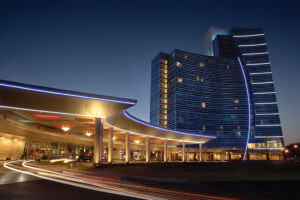 Blue Chip Casino Hotel Spa
Blue Chip Casino Hotel Spa
Experience 65,000 square feet of casino floor, soul-stirring rhythms on the dance floor, gourmet food, delicious snacks, pampering facials and luxurious hotel rooms at Blue Chip Casino. Gamers have the option of 44 table games, eight live poker room tables and more than 1,700 slots 24/7 all year round. For those looking to indulge, Blue Chip has six dining options available ranging from quick bites to fine dining. To take a load off, 486 luxury rooms and suites are available that include access to pools, fitness centers, in-room dining and special packages.
For more information, visit bluechipcasino.com.
Lubeznik Center for the Arts
Experience great art in the small town of Michigan City at Lubeznik Center for the Arts for a small donation of $3. Visitors can take in the many art exhibits on display, take part in a variety of art classes, get a behind-the-scenes tour of specific exhibits during the Kick It With the Curator event or take part in many of the First Friday events. Lubeznik also has a small shopping gallery where hundreds of artisans and craftsmen sell their work. During the winter season, thousands of items spill over into the lobby for their Holiday Artisan Market.
For more information, visit lubeznikcenter.org.
ACCOMODATIONS
The Bridge Inn
Just steps away from restaurants, boutique shopping and beaches is The Bridge Inn, a traditional bed and breakfast with 13 contemporary rooms, private baths, private sitting rooms and an outdoor deck. Bridge Inn also offers luxury suites with whirlpool bathtubs, and two-bedroom suites for families or groups. Some rooms offer kitchenettes while others offer full-sized kitchens, but Bridges Waterside Grille, the hotel’s on-site dining location, is also open for lunch and dinner, May through October.
510 E. 2nd St., Michigan City, IN 46360 | (219) 561-0066 | bridgeinnmc.com.
Resting on a former 170-acre dairy farm, Tryon Farm Guest House B&B is a destination “popular with visitors who seek the unique experience of sharing an immersion lifestyle in Michiana, where guests can enjoy the area while living like a local.” The guesthouse feels like a cozy retreat with private baths, luggage racks, empty dresser drawers, clothes hangers and shelves to give the “home” vibe. Four styles of rooms are available: the 1930s-inspired Alcove Room with a claw-foot soaking tub; The Cottage, a great room for reading, reflection and relaxation; the Prairie View room with an Art Deco design; and The Farmstead, with a full view of the farmstead outbuildings, dairy barn, chicken coop and fields.
1400 Tryon Road, Michigan City, IN 46360 | (219) 879-3618 | tryonfarmguesthouse.com.
Feallock House
Priding themselves on giving their customers individualized attention and providing personal touches to each stay, Jan and Harold Smith are the owners and innkeepers who interact with their visitors on a daily basis. Feallock House is located just eight short blocks from Lake Michigan and was constructed in 1866. Today, it is thought to be the oldest residence in the Elston Grove Historic District in Michigan City. The bed and breakfast has four guest rooms, a library and parlor. Special packages are available for businesses and multiple-night stays.
402 E. 8th St., Michigan City, IN 46360 | (219) 878-9543 | feallock.com.
DINING
Panini Panini
Named by Yelp users and editors as No. 7 on the list of top 50 restaurants in Indiana, Panini Panini has certainly developed a special place in the hearts of Hoosiers. With the menu changing seasonally, Panini Panini serves up a wide selection of soups, salads, sandwiches and entrees, along with a selection of fine wines and craft beers. Many of the restaurant’s Facebook reviewers have rated the restaurant a five-star experience and recommend the shrimp sandwich, pot roast sandwich and pesto linguine.
1720 Franklin St., Michigan City, IN 46360 | (219) 873-1720 | panini-panini.com.
Those looking for a world-class dining experience are encouraged to visit William B’s Steakhouse inside the Blue Chip Casino. The restaurant’s tables are draped with white, high-quality linen and fine china. Diners will discover fresh seafood and exquisite pasta dishes, all prepared with classic Midwestern flair. A wide range of specialties grace the menu, including braised short ribs, filet and stuffed shrimp, center-cut filet mignon, cedar plank salmon and Alaskan king crab legs.
777 Blue Chip Dr., Michigan City, IN 46360 | (888) 879-7711, ext. 2118 | bluechipcasino.com.
Say “Cheers!” at Shoreline Brewery, where customers can enjoy great food and drinks seven days a week. This brewery and restaurant located near the shores of Lake Michigan offers 12 beers on tap, including the World Beer Cup Award-winning Beltaine Scottish Ale, the Singing Sands Oatmeal Stout and several seasonal brews. In addition the beverages, Shoreline has become a place for families to relax in a warm, comforting, smoke-free environment. Diners can find items such as crab cakes on the appetizers menu, the Jamaican jerk chicken sandwich and Veracruz fish tacos.
208 Wabash St., Michigan City, IN 46360 | (219) 879-4677 | shorelinebrewery.com.
Holly’s Restaurant & Pub
If you’re on the hunt for a place where you can find all of your favorites — American and Mexican food along with slow-cooked barbecue — Holly’s Restaurant & Pub may have a dish crafted with you in mind. Surrounded by 15 large television screens, visitors can view sports games or their favorite daytime talk show while enjoying friendly service. The restaurant is operated by the three daughters of the Buda family, who inherited the restaurant from their father, Mike, after graduating from Purdue University’s Hospitality and Tourism school. Diners will enjoy sandwiches piled high with only the best-quality ingredients, delicious homemade soups and salads, and one of the best French Dip sandwiches. The eatery prides itself on big portions, so no customer ever walks away hungry.
3705 Franklin St., Michigan City, IN 46360 | (219) 879-5124 | hollysrestaurant.com.
Matey’s Restaurant
If your soul is calling for some late-night fun with both great service and drinks, Matey’s Restaurant is open until 3 a.m. Located on the marina, this restaurant serves up delicious meals and a place to enjoy a drink (or two) in the cocktail lounge, on the Tiki deck or in the sports bar. To spice things up a bit, the menu features a wide variety of Cajun and Creole items, along with an abundance of seafood, such as the coconut shrimp, breaded clam strips and others.
110 Franklin St., Michigan City, IN 46360 | (219) 872-9471 | mateysbar.com.
Three tips for getting past the HR representative
By Miranda Miller
Before the Internet, jobseekers only had to compete with locals who subscribed to the same newspaper, saw the same classified ad and took the initiative to type a cover letter, update their resume, address an envelope and buy a stamp. Today, everyone around the world has access to job postings on company websites, LinkedIn and aggregators like Monster.com and SimplyHired, many of which allow applicants to send a saved resume with one click. Since popular employers like Google receive millions of resumes, and human resources professionals spend an average of six seconds scanning each one, you may wonder what it takes to land an interview with the hiring manager. Here are a few tips:
Tip 1: Possess the qualifications the company seeks
Optimism is helpful while searching for a job, but it won’t get your foot in the door of your dream career if you don’t have the right credentials.
“Most all of our positions are engineering or architect-related positions,” said Dawn McMahon, who’s spent the past two years of her 12 years in human resources as talent acquisition specialist at DLZ, an award-winning consulting firm that employs nearly 600 people in seven states and takes pride in the fact that 80 percent of its business comes from repeat clients. “I look at each resume to see if (applicants) meet those qualifications.” For example, a position may require a bachelor’s degree in civil engineering, an EIT (engineer-in-training certification) or a PE (professional engineering license). Higher-level positions may require 10 or more years of experience. “If they meet those qualifications, I send them on to the hiring manager,” she says. “If they don’t, I don’t.”
When DLZ began interviewing in February for a lower-level structural engineer position that it posted last October, McMahon narrowed down 255 hopefuls to “about half.”
Tips 2 and 3: Research the company and tailor your resume accordingly
If you’re competing for a position in the IT field, “Education certainly plays a role, absolutely,” said Phelco Technologies President and CEO Tasha Phelps. “But in IT, it’s more about the experience and the certifications.”
Phelps also looks at community involvement, such as board memberships and volunteer activities. So while career counselors often advise jobseekers to save that information for the “What do you like to do in your spare time?” question during the interview, adding it to your resume might make the difference in getting the interview.
“I have high respect for someone who wants to give of their time, so I look for that information when I read a resume,” Phelps said. “It’s not always about going to work every day. It’s about what you’re doing in your community. At least from my perspective.”
That perspective is evident from Phelps’ LinkedIn profile and Phelco Technologies’ website, where a social responsibility page quotes Gandhi and lists nonprofit organizations that it supports. If applicants can show they espouse the same values as members of the company, they’re more likely to become one.


